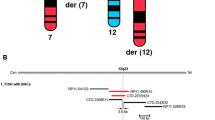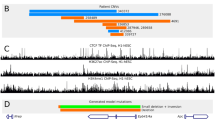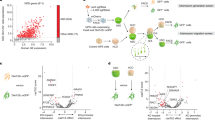Abstract
Caspr2 is a member of neurexin superfamily, members of which are transmembrane proteins that mediate cellular interactions in the nervous system. Recently, truncation of the CNTNAP2 gene coding for the Caspr2 protein has been suggested to be associated with the Gilles de la Tourette syndrome, a neurological disorder characterized by motor and vocal tics, and behavioral anomalies. In this study, we describe a familial balanced reciprocal translocation t(7;15)(q35;q26.1) in phenotypically normal individuals. The 7q35 breakpoint disrupts the CNTNAP2 gene, indicating that truncation of this gene does not necessarily lead to the symptoms of the complex Gilles de la Tourette syndrome.
Similar content being viewed by others
Log in or create a free account to read this content
Gain free access to this article, as well as selected content from this journal and more on nature.com
or
References
Rasband MN : It's ‘juxta’ potassium channel!. J Neurosci Res 2004; 76: 749–757.
Poliak S, Gollan L, Martinez R et al: Caspr2, a new member of the neurexin superfamily, is localized at the juxtaparanodes of myelinated axons and associates with K+ channels. Neuron 1999; 24: 1037–1047.
Poliak S, Salomon D, Elhanany H et al: Juxtaparanodal clustering of Shaker-like K− channels in myelinated axons depends on Caspr2 and TAG-1. J Cell Biol 2003; 162: 1149–1160.
Nakabayashi K, Scherer SW : The human contactin-associated protein-like 2 gene (CNTNAP2) spans over 2 Mb of DNA at chromosome 7q35. Genomics 2001; 73: 108–112.
Strauss KA, Puffenberger EG, Huentelman MJ et al: Recessive symptomatic focal epilepsy and mutant contactin-associated protein-like 2. New Eng J Med 2006; 354: 1370–1377.
Verkerk AJMH, Mathews CA, Joosse M et al: CNTNAP2 is disrupted in a family with Gilles de la Tourette syndrome and obsessive compulsive disorder. Genomics 2003; 82: 1–9.
American Psychiatric Association: Diagnostic and Statistical Manual of Mental Disorders, Fourth Edition (DSM-IV), Washington DC, 1994.
Pauls DL : Update on the genetics of Tourette syndrome. Adv Neurol 2001; 85: 281–293.
Abelson JF, Kwan KY, O'Roak BJ et al: Sequence variants in SLITRK1 are associated with Tourette's syndrome. Science 2005; 310: 317–320.
Kirchhoff M, Gerdes T, Rose H, Maahr J, Ottesen AM, Lundsteen C : Detection of chromosomal gains and losses in comparative genomic hybridization analysis based on standard reference intervals. Cytometry 1998; 31: 163–173.
Bache I, Hjorth M, Bugge M et al: Systematic re-examination of carriers of balanced reciprocal translocations: a strategy to search for candidate regions for common and complex diseases. Eur J Hum Genet 2006; 14: 410–417.
Acknowledgements
We are grateful to the family for their cooperation. We thank Minna Becher, Karen Friis Henriksen, Anita Niebuhr, Kirsten Winther for their skillful technical assistance. Wilhelm Johannsen Centre for Functional Genome Research is established by The Danish National Research Foundation.
Author information
Authors and Affiliations
Corresponding author
Additional information
Online information
Online Mendelian Inherance in Man (OMIM) (http://www.ncbi.nlm.nih.gov/entrez/query.fcgi?db=OMIM).
Human Genome Browser, UCSC genome bioinformatics (http://genome.ucsc.edu/cgi-bin/hgGateway).
Rights and permissions
About this article
Cite this article
Belloso, J., Bache, I., Guitart, M. et al. Disruption of the CNTNAP2 gene in a t(7;15) translocation family without symptoms of Gilles de la Tourette syndrome. Eur J Hum Genet 15, 711–713 (2007). https://doi.org/10.1038/sj.ejhg.5201824
Received:
Revised:
Accepted:
Published:
Issue date:
DOI: https://doi.org/10.1038/sj.ejhg.5201824
Keywords
This article is cited by
-
Cryptic breakpoint identified by whole-genome mate-pair sequencing in a rare paternally inherited complex chromosomal rearrangement
Molecular Cytogenetics (2018)
-
Candidate Genes for Inherited Autism Susceptibility in the Lebanese Population
Scientific Reports (2017)
-
Phenotypic subregions within the split-hand/foot malformation 1 locus
Human Genetics (2016)
-
Gilles de la Tourette syndrome is not linked to contactin-associated protein receptor 2 antibodies
Molecular Brain (2015)
-
Shining a light on CNTNAP2: complex functions to complex disorders
European Journal of Human Genetics (2014)



